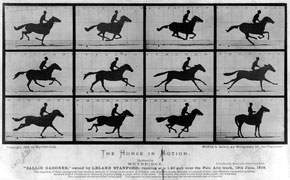 If you’ve visited Google today, you probably noticed the equine-themed Google Doodle, or today’s themed variation on the usual logo. Today’s Doodle is commemorating the 182nd birthday of photographer Eadweard Muybridge. Click on the play button, and the still photos move to show the horse galloping. The series of photos, called Sallie Gardner at a Gallop, or sometimes simply The Horse in Motion, was revolutionary when Muybridge created it in 1878. The images answered a long-debated question about whether there was ever a moment when all four of a galloping horse’s hooves left the ground.
If you’ve visited Google today, you probably noticed the equine-themed Google Doodle, or today’s themed variation on the usual logo. Today’s Doodle is commemorating the 182nd birthday of photographer Eadweard Muybridge. Click on the play button, and the still photos move to show the horse galloping. The series of photos, called Sallie Gardner at a Gallop, or sometimes simply The Horse in Motion, was revolutionary when Muybridge created it in 1878. The images answered a long-debated question about whether there was ever a moment when all four of a galloping horse’s hooves left the ground.
Prior to Muybridge’s photography, artists often depicted galloping horses in full extension, like a greyhound, with front and back legs extended. Muybridge’s work showed that such a moment never actually occurs in the gallop. The moment of suspension is actually when all four legs are bent underneath the horse’s body.






cool bit of history
It was revolutionary! It changed the way paintings were depicted. But I guess you already said all that in the article!
Thanks for the history tidbit.
Thanks for the history.